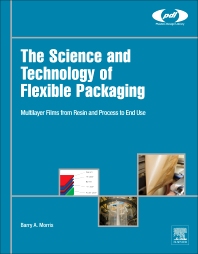
Table of Contents Series Page Preface Part I. Why Multilayer Films? 1. Introduction 1.1. History of Packaging 1.2. Benefits of Packaging 1.3. Consumption Patterns 1.4. Packaging Value Chain 1.5. Needs Along the Value Chain 1.6. Assembling a Package: Benefits of Multiple Layers 1.7. Packaging Trends in the Context of the Value Chain Part II. Basic Processes 2. Converting Processes 2.1. Extrusion 2.2. Film Converting 2.3. Coating and Lamination 2.4. Orientation 2.5. Printing 3. Packaging Equipment 3.1. Brief Description of Packaging Equipment 3.2. Unit Operations Part III. Material Basics 4. Commonly Used Resins and Substrates in Flexible Packaging 4.1. Resin and Substrate Function 4.2. Commonly Used Resins in Flexible Packaging 4.3. Commonly Used Substrates in Flexible Packaging 4.4. Material Specifications 4.5. Regulatory Considerations 5. Rheology of Polymer Melts 5.1. Basic Terms 5.2. Importance of Rheology in Flexible Packaging 5.3. Rheological Measurements 5.4. Factors Influencing Polymer Rheology 5.5. Relaxation, Creep, and Constitutive Equations 6. Polymer Blending for Packaging Applications 6.1. Introduction 6.2. Why Blend? 6.3. Blending Processes 6.4. Physics of Blending 6.5. Morphology Development in Blown Film 6.6. Dispersion of Rigid Particles and Nanocomposites 6.7. Rheology of Polymer Blends 6.8. Conclusion Part IV. Film Properties Introduction 7. Heat Seal 7.1. Why It Is Important 7.2. How to Measure 7.3. Typical Values 7.4. Factors That Influence Heat Seal Performance 7.5. Science of Heat Sealing 7.6. Modeling Heat Seal and Hot Tack 7.7. Easy-Open Seal Technology 7.8. Reclosable Seal Technologies 7.9. Ultrasonic Sealing 7.10. Failure Analysis and Troubleshooting 7.11. Selecting Sealant Resins 8. Barrier 8.1. Why It Is Important 8.2. How to Measure 8.3. Typical Permeation Values 8.4. Science of Permeation 8.5. Emerging Technologies 9. Strength, Stiffness, and Abuse Resistance 9.1. Why It is Important 9.2. How to Measure 9.3. Typical Values 9.4. Engineering Principles for Multilayer Films 10. Adhesion 10.1. Why Adhesion is Important 10.2. How to Measure Adhesion 10.3. Fundamentals 10.4. Tie Resin Technology 11. Thermoforming, Orientation, and Shrink 11.1. Thermoforming 11.2. Orientation and Shrink 12. Frictional and Optical Properties 12.1. Frictional Properties 12.2. Optical Properties Part V. Effect of the Converting Process on Properties Introduction 13. Effect of Processing on Quality 13.1. Thermal Stability 13.2. Die Drool 13.3. Moisture-Related Issues 13.4. Flow Maldistribution and Instability Issues 13.5. Curl 14. Effect of Process on Properties 14.1. Stress–Strain History in Blown Film 14.2. Air- Versus Water-Quench Blown Film 14.3. Development of Blend Morphology in Blown Film 15. Effect of Processing on Interlayer Adhesion 15.1. Adhesion to Substrates in Extrusion Coating 15.2. Interlayer Adhesion in Coextrusion Part VI. End Use Considerations 16. End-Use Factors Influencing the Design of Flexible Packaging 16.1. Environmental Effects on Package Performance 16.2. Packaging–Product Interactions 16.3. Aging 16.4. General Considerations 16.5. Cost Part VII. Structure Design and Modeling 17. Analytical and Modeling Tools for Structure Design and Process Optimization 17.1. Identification of Packaging Structures 17.2. Modeling Appendix A. Writing Guide for Packaging Films and Other Multilayer Structures Appendix B. Examples of Flexible Packaging Film Structures Index Description The Science and Technology of Flexible Packaging: Multilayer Films from Resin and Process to End Use provides a comprehensive guide to the use of plastic films in flexible packaging, covering scientific principles, properties, processes, and end use considerations. The book brings the science of multilayer films to the practitioner in a concise and impactful way, presenting the fundamental understanding required to improve product design, material selection, and processes, and includes information on why one material is favored over another for a particular application, or how the film or coating affects material properties. Detailed descriptions and analysis of the key properties of packaging films are provided from both an engineering and scientific perspective. End-use effects are also covered in detail, providing key insights into the way the products being packaged influence film properties and design. View more > Key Features Provides essential information on all aspects of multilayer films in flexible packaging Aids in material selection and processing, shortening development times and delivering stronger products Bridges the gap between scientific principles and key challenges in the packaging industry, with practical explanations to assist practitioners in overcoming those challenges Readership Engineers and Scientists responsible for designing polymers, making film, specifying packaging, running or operating film lines and packing lines, industrial designers, and consultants. Industry Sector – Packaging, especially flexible packaging, including food and non-food packaging (e.g., medical) Details No. of pages: 744 Language: English Copyright: © William Andrew 2017 Published: 15th September 2016 Imprint: William Andrew Hardcover ISBN: 9780323242738 eBook ISBN: 9780323243254 About the Author Barry Morris Barry A. Morris is a technical fellow at DuPont with over 30 years of experience in packaging innovation and technology. He has had a variety of roles supporting DuPont’s ethylene copolymer business, including technical service, application development and R&D. He holds ten U.S. patents and has written for over 100 publications. He is a Fellow of the Society of Plastics Engineers, a long time board member and past chair of the SPE Extrusion Division, and a founding member and current chair of the SPE Flexible Packaging Division. A longtime member of TAPPI, he won the PLACE Division’s technology award in 2005 in recognition of his outstanding contributions to the advancement of flexible packaging technology. Affiliations and Expertise Technical fellow, DuPont







